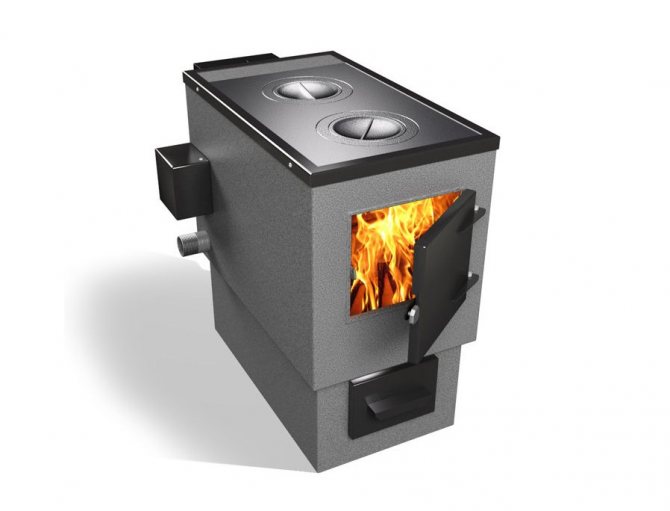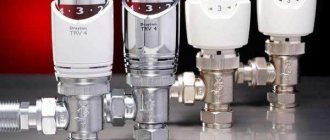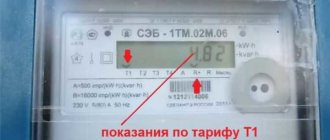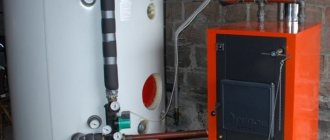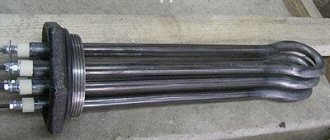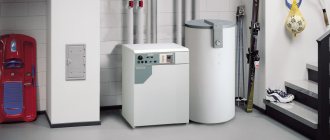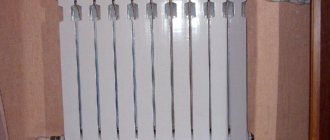The supply of vegetables from distant southern countries in the winter provided the counters with tomatoes, cucumbers, herbs, eggplants and other exotic agricultural products. The first euphoria from such an abundance did not last long: buyers quickly realized that they had to pay a high price for the beautiful appearance of vegetables - their health.
Agricultural chemistry and genetic modification make it possible to make products that can withstand long-term transportation and long-term storage, hitting the shelves in perfect condition. More and more buyers are deliberately abandoning overseas products in favor of greenhouse vegetables and fruits.
Greenhouse heating boiler
Greenhouse in our country actively reviving, powerful complexes and numerous private farms appear, which supply quality products to our tables.
The specificity of the country's climate makes
take seriously the heating of greenhouses and greenhouses, must be equipped soil and air heating system maintaining optimal temperatures. For her, it is worth choosing an economical boiler with high efficiency, which will minimize the cost of growing agricultural products in the winter. Do not forget about modern technologies such as gsm moduleswhich will allow using a smartphone to monitor the operation of heating equipment online.
Polycarbonate greenhouse stove heating
For even distribution of heat throughout the entire volume of the greenhouse, it is recommended to make stove heating based on a water boiler. Moreover, the boiler itself should not be in the greenhouse, but stand apart. It is also easy to build such a system:
- Next to the greenhouse, build a room in which to install the stove.
- Install heating devices inside the greenhouse: these can be convectors, standard cast-iron or aluminum radiators, even a floor heating system.
- Lay the pipeline, not forgetting the need for thermal insulation of open pipe sections.
- Pour coolant into the system - you can use both water and antifreeze.
There are many options for heating a polycarbonate greenhouse using a stove: it can be firewood, coal, mining, gas or diesel fuel. It all depends on the type of boiler you choose and the availability of specific resources in your region.
What kind of boiler is needed for a greenhouse?
The classic hot water heating system is perfect for a greenhouse. It allows you to simultaneously heat the soil and air. For this, pipes are laid in the ground, and heating radiators are removed from the outside. The specificity of the operation of this system is a large difference in the temperature of the coolant at the inlet and outlet. After circulation in the system, the water can cool down to 45-50 degrees! Not all heating equipment can cope with such a difference; the most correct solution would be to install a condensing gas boiler. This technique has the following advantages:
- Low fuel cost;
- High efficiency of equipment;
- Use of steam energy;
- Compact dimensions;
- Simple controls.
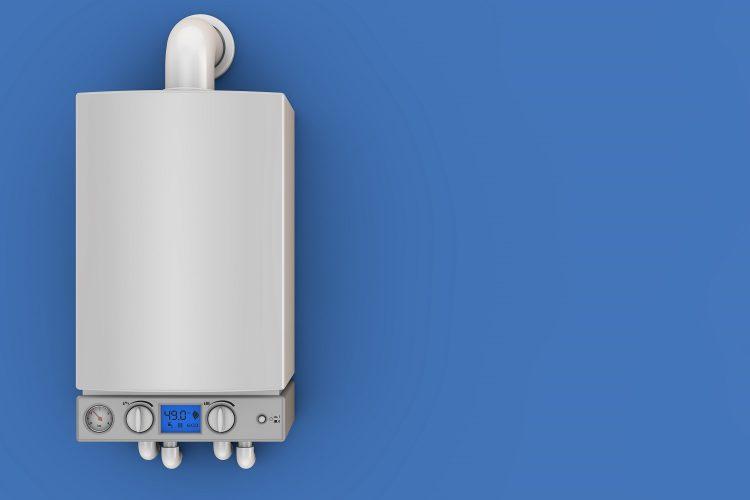
Condition efficient operation of condensing gas boilers is the low return temperature. Steam condensation occurs when 50 ° C and according to this indicator, the greenhouse water heating system fully meets the requirements of equipment manufacturers. In such conditions Efficiency boilers reaches 107-109%, which provides economical heating of greenhouses of farms.
High technologies do not always contribute to the high quality of greenhouse heating. Solid fuel boilers for long burning and pyrolysis models are popular with fans of autonomous heating due to the availability of fuel and its environmental friendliness. It is not recommended to use this technique for heating the greenhouse, since the low temperature of the coolant in the return line will cause condensation to form on the inner walls of the boiler and the heat exchanger. When mixed with combustion products, aggressive solutions are formed that destroy the walls of expensive equipment.
In the absence of gas heating, the best choice would be classic solid fuel boiler... He will perfectly cope with the task, but will require increased attention.
If a pyrolysis boiler or a solid fuel model of continuous combustion has already been purchased, then it will be necessary to think over a return heating system to a temperature higher 50 ° C.
Charcoal - Benefits in Agriculture
Charcoal as a plant food in the fields has become widespread relatively recently. Agronomists note that its use helps to improve plant fertility, and also helps plantings to more easily tolerate drought.
The following advantages of this fertilizer can be distinguished:
- Environmental friendliness - the product is absolutely harmless to both animals and humans.
- Frequency of use - the ability to apply it to the soil for several years without interruption.
- Affordability - The cost of coal is much cheaper than chemical fertilizers.
- High porosity - low weight of the substance and the minimum amount for feeding large areas.
Plants treated with coal ash infusion are less susceptible to fungal diseases and pest attacks.
Charcoal as a regulator of soil moisture
The uniqueness of this wood fertilizer is due to its ability to absorb water. Due to the absorption of excess moisture, the roots of plants are protected from decay in the rainy season. During drought, the particles of wood material return the accumulated moisture to the soil. Thus, activated carbon in horticulture corrects soil moisture.
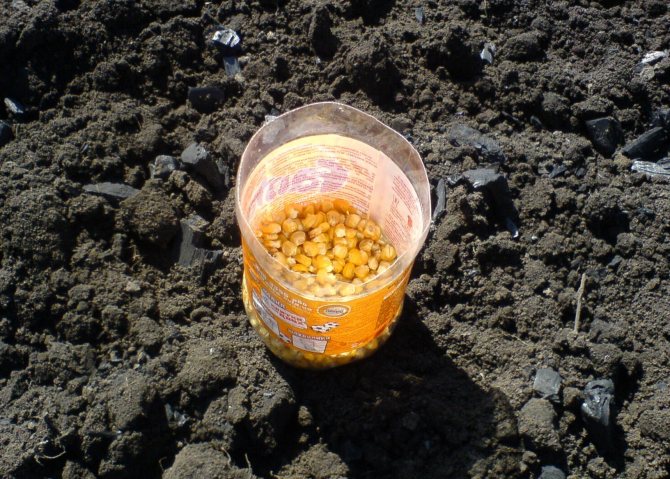

In addition to moisture, useful microelements are collected over time on the caked shell of a coal product. They additionally nourish the root system of planting, increasing the looseness of the soil and improving its quality.
Protecting the garden from pests
To protect plantings from pests and various diseases, an infusion of wood ash can be used. The solution is well known among opponents of the use of "chemistry" in the backyard. Brown coal as a fertilizer is effective in the fight against fungus (powdery mildew, black leg, gray rot) and against the invasion of pests.
Prepare the solution as follows:
- 300 g of wood ash is poured with 2 liters of boiling water.
- The mixture is boiled for 30 minutes.
- Add 8 liters of water.
- A little tobacco ash is poured into the infusion along with 50 g of laundry or tar soap.
Garden plants should be sprayed with a soap-ash solution in the evening. It will protect plantings from wireworms, Colorado potato beetles, slugs, aphids, white beetles, ticks, ants and various midges. The drug will save berry bushes from sawfly and powdery mildew.
Dry ash treatment is recommended to protect cabbage. The dusting method will ensure the safety of the plant from slugs and small fleas. This method of feeding is environmentally friendly - eating the fruits of processed plants is completely safe.
Where to install the heating boiler?
For large greenhouses, you can build a separate boiler room, in medium sized greenhouses it is better to install heating equipment directly at the entrance to the premises... Is it necessary to enclose the boiler? This is not necessary, especially in the case of using gas heating equipment.If preference is given to a solid fuel boiler, then you should make sure that there is a supply of dry fuel next to the boiler. With high air humidity in the greenhouse, it is worth making a separate room for storing fuel.
How to choose a greenhouse boiler: advice from experienced farmers
A greenhouse boiler is the equipment that will allow you to get a good harvest even in severe frosts. Everyone knows how much vegetables cost in winter, so your vegetables during this period are a very profitable solution. But every vegetable grower who decides to start heating the greenhouse may face the difficulty of choosing a boiler, because there are several varieties of them on the market. Which one should you choose for this or that site? Or maybe it will be easier and cheaper to make it yourself from scrap materials?
Greenhouse boiler options
At the moment, the following boilers for greenhouses are massively used:
- wood-burning;
- combined (wood-coal);
- pellet;
- gas;
- electrical.
They are conventionally classified into two more subspecies. Solid fuel boilers are the above-mentioned first three types. Long-burning boilers are classified in a separate category, since the principle of their operation is not tied to the combustion of materials, but to their smoldering, for which a controlled oxygen (air) supply system is used. They are the most efficient and economical, but they are quite expensive.
The simplest heating boilers for greenhouses are gas and electric. However, it is impossible to call them economical and profitable in the current situation. Gas and electricity are already too expensive for heating, and additional price increases are expected in the future. Therefore, such boilers are used only for an emergency, when other heating options are simply not available for any reason.
You can also cook a wood-burning boiler yourself, but this will turn out to be a banal potbelly stove. Its advantages are cheapness and efficiency, and its disadvantages are the inability to regulate the temperature, the need to constantly add fuel (wood or coal), as well as uneven heating of the greenhouse area. Their use will be justified only if we are talking about a polycarbonate or glass greenhouse with steam heating (or where pipes are laid in the ground at a depth of about 50 centimeters). And such a boiler for heating a greenhouse is suitable only for small areas. If the greenhouse occupies more than 50 square meters, then several "burzhuyki" will be required. Keeping track of them is extremely difficult and troublesome.
But there is also a very big advantage in wood-burning and long-burning boilers for solid fuel greenhouses. The product of their mining is ash and ash, which are extremely useful "ingredients" for growing any vegetable and fruit crops. And in the case of beets, for example, ash allows you to get rid of any insect pests and save a lot of money on the purchase of agricultural chemicals (pesticides and mineral fertilizers). For a vegetable grower, this is far from the last advantage.
How to choose
You need to choose a boiler, focusing on the area of \ u200b \ u200bthe room. Usually they are based on such parameters - for 1 sq. m greenhouses need a minimum 120 watts (with a ceiling height of three meters). This means that the capacity of the boiler or other equipment must be quite large.
Selection recommendations greenhouse boiler:
- high power and high efficiency of the device;
- ease of maintenance and minimal human control;
- affordable fuel;
- easy installation equipment in the greenhouse itself;
- simple chimney arrangement or chimney;
- 100% waste disposal outside (otherwise plants may die);
- possibility of creating mild microclimate inside the greenhouse;
- optimal price for the boiler itself and its maintenance.
Reference. If there is no time to service the heating system, it is better to choose gas and electric models boilers. They are significantly more expensive, but the costs are justified.
If you constantly live next to the greenhouse, and it is small in size, then it is quite possible to get by with boilers or stoves where you need to lay firewood.
Which boiler to choose for a greenhouse
When choosing a boiler for heating greenhouses, you need to take into account both the area of the heated room and your financial capabilities. Ideal - long burning, but they cost an average of 100 thousand rubles. But their consumption is 2 styling for 24 hours. In large greenhouses, they fully pay for themselves in just 1-2 seasons (if firewood or coal is purchased). In small ones, with an area of about 15-20 square meters, the payback will stretch for almost 10 seasons.
For the latter option, simple solid fuel heating boilers or those that run on gas are ideal. The efficiency of the system will be significantly higher if it is supplemented with a pump for pumping water through pipes. This, by the way, will provide even heating of the heated room.
An electric boiler, as practice shows, is a waste of money. They are inefficient, consume too much electricity and only raise the temperature in the upper part of the greenhouse. The volume near the ground remains cold, which leads to freezing of plants.
Combined long-burning boilers are classified as industrial ones.
They should be bought only if the greenhouse is over 100 square meters and those crops are grown in it that react extremely sharply to a change in microclimate.
These are, for example, bell peppers, wild strawberries, strawberries, raspberries, eggplants, carrots, potatoes. They cost, respectively, from 200 thousand rubles. But the savings are huge! And boilers of this type also operate on liquid fuel (meaning processed oil, fuel oil, oil industry waste).
A few words must be said about the pyrolysis boiler, which is conditionally a derivative of solid fuel long burning. Its operating principle is based on burning wood gas. It has a very high heat transfer, since the flame is supplied through the nozzle as from an autogen, thereby quickly heating the water tank. In this case, heat can be dissipated into a steam heating system or by a fan through a radiator. Such a boiler is both efficient and economical, but it takes up a fairly large space (including in height). Not suitable for small greenhouses, as it can burn plants in them. The landing distance from the boiler is at least 50 centimeters.
Emergency heating boilers
An experienced vegetable grower always has at his disposal heating boilers of various types, since one of them may turn off due to an interruption in gas supply, electricity, or simply break down. So, for emergency cases, electric ones are ideal, where the heating element is heated, and the heat is dissipated by the cooler. But they should be supplemented with a stand-alone generator.
The most common wood-burning stove is also an excellent solution for emergency heating of the greenhouse volume. But its construction should be done in advance. Smoke can be removed in several ways. But we must not forget that a foul gas for plants is not harmful and reduces thermal conductivity. Thanks to this, the cooling rate of the greenhouse will be significantly reduced.
Every vegetable grower can use a mobile pellet boiler. It is quite easy to transport, but it is useful for burning any solid fuel, including corn cobs. In this case, heating occurs quickly and evenly. The only drawback is the need to have a chimney, and in a strong wind it will blow out from the outside. That is, a large amount of smoke will enter the greenhouse. Plus, pellet boilers are demanding to maintain.They quickly accumulate moisture, which is removed only mechanically. In any case, this is an excellent option for emergency heating, in which the fuel can even be combined (for example, kindling with wood, maintaining the temperature with coal or peat).
Greenhouse heating boiler: wood, electricity and gas
Now we will consider options for boilers for heating a greenhouse and see which one to choose. It can be a wood-fired boiler, gas or electric.
Currently, a healthy lifestyle is massively popularized. The physical condition of a person depends, first of all, on what foods he eats. Therefore, today more and more people are trying to eat right.
As you know, vegetables and fruits that lie on store shelves are stuffed with nitrates and other poisons, so many decide to grow their own food and resort to using greenhouses. In order for the plants to grow well, it is necessary to maintain a comfortable temperature in the greenhouse, especially in winter when the air temperature is low.
Moreover, for the normal growth of your vegetation, it is important to heat not only the air, but also the earth. If this is not done, the grown products will simply die. In order to prevent this from happening, it is worth getting a boiler for heating greenhouses. This is the equipment that will act as a source to maintain the desired temperature in your "winter garden".
The main factors that affect the choice of heating method for greenhouses are the cost and stability of the temperature regime. Therefore, it is important to choose a good heating unit.
Greenhouse boilers are:
- solid fuel;
- gas;
- electric.
Solid fuel boilers
Today, wood-fired heating units are the most common and affordable. This is due to their high productivity and efficiency, because ordinary firewood, waste from furniture and woodworking industries, wood scraps, branches cut from trees and even dry garbage act as fuel for them.
You can choose among the following types of solid fuel boilers:
- wood (conventional or pyrolysis);
- coal and wood;
- pellet (work on compressed pellets made of wood, seeds, straw, various waste).
Solid fuel greenhouse boilers have many advantages:
- environmental friendliness;
- cheapness;
- availability;
- security;
- aesthetics;
- non-explosiveness.
The efficiency of such boilers is in the range of 75–90%.
Using solid fuel boilers as a way to heat the greenhouse, you can be content with fresh vegetables and fruits all year round.
However, such devices also have some disadvantages:
- To store such devices, you need a "solid" area.
- It is necessary to prepare fuel in advance.
- They require regular maintenance (cleaning the boiler furnace from ash, filling fuel).
How to make a greenhouse boiler with your own hands
If you want to save a budget and do not want to buy a ready-made unit, then you can make a solid fuel boiler for heating the greenhouse with your own hands.
To do this, you need to perform a number of actions:
- Get a barrel, the volume of which is 3 cubes.
- Using a drill, drill three holes in it, which will serve for the outlet of the chimney, drain and expansion tank.
- At the next stage, a 5 m high chimney is attached to the barrel. This device will be responsible for removing carbon dioxide from the greenhouse.
- An expansion tank must be attached to the top of the barrel, you can weld it yourself.
- Then, a heating system needs to be laid in the greenhouse, the best and cheapest way is plastic pipes.
- Using a special soldering iron, you need to weld the pipes together.
Plastic is not subject to rust, corrosion and is able to maintain performance despite temperature changes and high humidity.
Boiler classification
Boilers used to heat greenhouses are most often of three types:
Each of these large groups of boilers can be classified more specifically depending on what kind of fuel is used for heating.
Solid fuel boilers for greenhouses are divided into the following types:
- wood-fired boilers with a conventional firebox or slow-burning chamber;
- coal and wood boilers;
- pellet boilers.
Gas boilers used to heat greenhouses can be:
- single-circuit;
- double-circuit;
- with direct thrust;
- with forced draft.
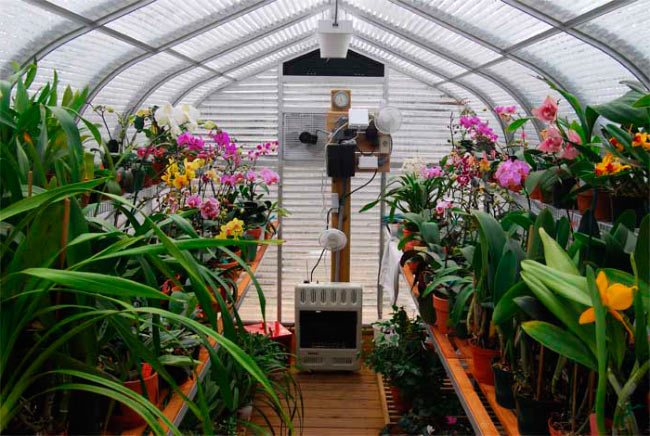

Also, gas boilers are divided into the following types:
- boilers with tubular electric heaters;
- induction boilers.
Electric boilers can also be classified. They are divided into the following types:
- electric boilers of direct action;
- electric boilers of indirect action.
Each of these boilers for heating greenhouses has its positive and negative sides.
Gas devices
Greenhouse gas boilers are a good option. They guarantee uninterrupted operation and heating of the greenhouse at a level suitable for vegetation. The boiler automation ensures its autonomous operation, while human participation in this case is limited.
Using gas heating, you can heat the greenhouse in one of the following ways: air, water, infrared.
Infrared gas heater for greenhouse
Most often, infrared gas heaters are installed on the roof. This is due to the fact that gas infrared heating of the greenhouse in winter has one important advantage: first, the soil is heated, and only after it is the air.
The disadvantage of such heating is the need to install ventilation to remove combustion products.
The second option is heating the greenhouse with a gas boiler together with a water system.
Greenhouse gas boiler
To activate this heating method, it is necessary to perform wiring from smooth pipes with a diameter of no more than 40 mm over the entire area. They should be laid along each bed 20-30 cm above ground level. It is allowed to use the following types of wiring:
- The supply line is along one wall, the return line is near the other. They are interconnected by transverse pipes running between the beds.
- The supply and return are laid along the same wall. Each heating pipe goes along one bed and returns past another.
- The pipe is laid in a snake over the entire area of the greenhouse, forming a single heating circuit.
It is imperative that cut-off valves be mounted on each branch so that it is possible to turn off the circuit in the event that there is no vegetation in the greenhouse.
In the greenhouse heating system using a gas boiler, the main advantages can be noted:
- autonomous operation of the device;
- ease and speed of boiler maintenance;
- high efficiency.
- It is difficult to conduct gas to the greenhouse: a special service must be called.
- The high cost of gas tariffs, especially in the summer.
Electric boilers
Electric boilers are easy to use and affordable wherever power lines are established. But if you want to purchase an electric boiler to heat the greenhouse, then you should understand that such equipment is quite expensive, and its use is not always advisable and justified. In addition, blackouts often occur now, and during such a period your vegetation may simply simply die.
However, such heating, per unit of heat, is the most expensive. In addition, to connect an electric boiler, a separate line is required, and often not for 220 V, but for 380 V, and the wiring of such a line is a complex, lengthy and expensive process, moreover, this option is not always possible due to the lack of technical capability.
The advantages and disadvantages of an electric greenhouse boiler are as follows.
| Benefits | disadvantages |
| Low cost of equipment. | The need for a permanent connection to the mains. |
| Availability. Can be purchased at any major hardware store. | High energy costs. On average, electricity bills when using such a heat source increase by 10-20%. |
| Convenient control system, so there are no difficulties with operation. | |
| No combustion products, no need to equip the chimney. | |
| Minimal maintenance. The electric heating element does not need to be cleaned of soot or dirt, as, for example, in solid fuel boilers. Maintenance is required approximately every 2-3 years. | |
| They are convenient in location, do not take up much space, most of the devices are wall-mounted. |
A greenhouse is a great opportunity to please yourself and your loved ones with fresh and natural vegetables, greens, not only in summer, but also in winter. In order to successfully grow vegetables and ultimately harvest a good harvest, you need to ensure a good temperature in the greenhouse. Boilers for heating greenhouses are assistants in this matter. Each heating method has its pros and cons, therefore, in each case, one or another option may be the most optimal.
Based on your capabilities, you can choose the right option and ensure the fruitful growth of your plants.
The most efficient heating systems for industrial greenhouses: features and benefits
Reading time: 6 minute (s)
For the central and northern regions, it is very problematic to grow thermophilic crops. Therefore, many summer residents use industrial greenhouses with heating.
Thanks to the artificial maintenance of the microclimate inside, even in the most severe frosts, it is possible to grow vegetables, fruits and melons all year round. There are many ways to heat. Which is better?. This is what will be discussed in this article.
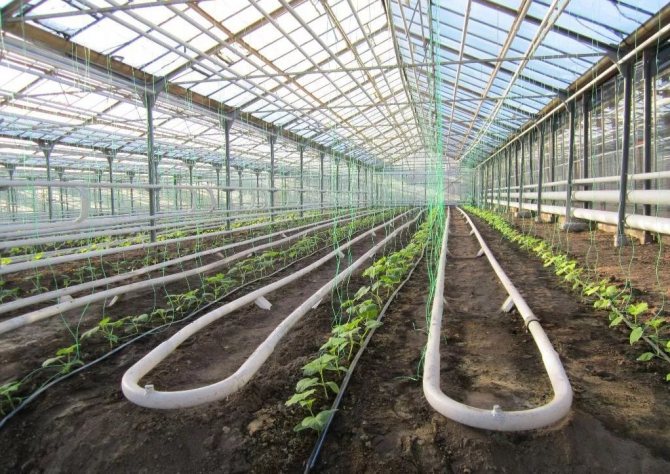

Available heating options
Central


It is advisable to use this type of heating if a heating main passes nearby. All this is mounted using a classic scheme using convectors or registers.
A one-pipe filling is installed in parallel.
This is an inexpensive pleasure in the initial stages, but as it is used, maintenance, repairs and payment for services will not be cheap.
Because the summer resident will have to deduct funds to the state budget, pay for pipe repair services, etc.
Therefore, the advantages of central heating include the fact that the owner of the site does not need to constantly add fuel to the stove and independently regulate the temperature.
But the cost of operating the equipment is expensive and this is a minus.
Electrical


Heating with electric types of heaters is expensive for summer residents. This is a rather expensive task, because for 1 m3 it is necessary to spend 150 watts. electricity.
But there are some additional devices that can significantly save on electricity.
Let's start with the fact that in warm weather or sunny days, electricity will be consumed less.
And as additional equipment, you can install heat pumps (we'll talk about them later), which will move the heated air, and not just generate it.
Therefore, electricity should be used as the main source of heat only if heaters are installed with other devices that reduce electricity consumption.
Stove (boiler room)


Your own boiler room is not considered the cheapest option. Solid fuel boilers consume the following types of fuel:
- coal;
- firewood;
- fuel oil.
When building a boiler room, you will have to fork out a lot. The only caveat is the significant loss of the body during transportation and the cost of fuel.
But, not all regions have a gas pipe, and many settlements have problems with electricity. Therefore, just in such problematic regions, the installation of a solid fuel boiler is the most ideal option.
Gas


Gas in our country is the cheapest source of energy. There are two ways to heat a greenhouse with gas.
- Fill cylinders and connect to the heating system.
- Connect directly to the gasified pipe.
The second option is acceptable if there is a gas pipe nearby. In this case, even installing a boiler in the future will pay off all costs. Unfortunately, not all regions of our country are supplied with gas. Therefore, you have to carry cylinders from afar.
Heat pumps


There are a lot of units. Their variety allows you to choose the best option for the room. But, unlike other heating devices, they do not generate energy, but move it from cold objects to warm ones.
Air-to-air - this includes a classic air conditioner. Cold air is driven from the street through a fan, which passes through the heat exchanger. Cooling takes place in a similar way. It is an inexpensive device, but its power is limited.
Ground-air and ground-water use the principle of geothermal heat in their work. Wells are drilled in the soil, where probes are mounted to heat the soil.
Water heat exchangers. To do this, use a reservoir that does not freeze at low temperatures. The heat exchanger is placed in water and takes energy from there.
IR heating
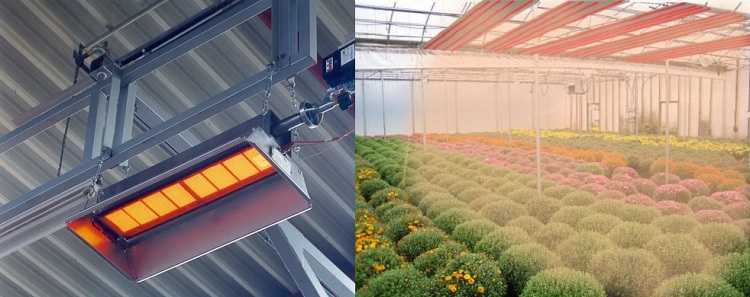

Devices that emit infrared radiation are characteristic of saving heat. To do this, they are mounted on the ceiling so that the heat is evenly distributed to all types of crops.
Radiation heats directly plants and soil.
As a result, the temperature of + 5 ° C can easily rise to 25 ° C. But, in order to achieve this result, it is necessary to raise the equipment no higher than 3 meters.
ATTENTION! Plants can burn if the heaters are lowered lower.
What kind of fuel is better to use
Firewood, coal
Used for solid fuel boilers. The advantage of this type is that, having purchased a sufficient amount of solid fuel, you do not have to worry about the operation of the boiler. I went to the unit, threw in another batch and that's it - the greenhouse is heated further.
At the same time, firewood is considered more economical, especially if the site is located next to the forest.
In other cases, buying it is a real problem. You never know how cold winter can be.
But for residents where there is no gasified line and there are problems with electricity, this fuel is best suited.
Biofuels
- Economy option. This includes animal manure and plant waste.
- Animal dung gives off a lot of heat. But you need to choose fuel, depending on the heating of the room.
- Horse manure is considered one of the best types of fuel. Its temperature reaches 60 ° C, but over time it drops to 35 to 40 ° C. It lasts about 3-4 months.
- Cow dung is practically no different from horse dung. But there is still a difference. The temperature emitted by the briquette reaches only 20 ° C, but it is maintained for 3 months.
- Sheep (goat) manure keeps the temperature from 30 to 35 ° C. It lasts from 90 to 120 days. But you need to be careful with him. The composition contains a large amount of nitrogen and this can cause plant burns.
- Pig manure is inferior to the previous options. It gives 14 - 16 ° C thermal energy for 70 days.
- Rabbit droppings are never used directly. It is usually diluted with compost (5 - 5%).
Plant species include:
- straw;
- bark of trees;
- sawdust;
- herbaceous vegetation;
- peat (not strongly decomposed);
- compressed household waste.
Gas
The cheapest form of energy.It is advisable to use it only if there is a gasified pipe nearby. In other cases, it is necessary to purchase cylinders from distant settlements. Using gas, you can easily heat large areas and not think about financial waste.
Solar energy
It can be used as efficiently as possible if the greenhouse is located in sunny regions. At the same time, even on cloudy days, the LEDs will collect energy and heat the room. This is felt during the period from November to April, when there is a great lack of light.
The advantage of this type of heating is that, even on cloudy days, the greenhouse plants will be heated.
ATTENTION! To maximize the use of all solar energy resources, LEDs should be installed in the most illuminated area of the greenhouse.
Electricity
One of the most expensive types of electricity. But it must be used wisely. If electricity is used to turn on additional devices and distribute it between them, then the use of electricity greatly simplifies this procedure.
That is, if you installed some heaters or other electrical appliances, then heating the room will not pay off in any way. But, additional use of the air conditioner significantly reduces costs.
You can install one instead of three systems, and in addition install a heat pump.
It will transform cold air into hot air.
Water
Used by a water heating boiler. The circulating pump draws a large amount of water through it. This is one of the most economical ways to heat a large room.
The water will be heated using a gas boiler or electricity.
All pipes are closed in a circuit. They are stretched either indoors or buried in the ground. Passing through the coolant, the water heats up and heats the room, then returns to the tank. And the cycle repeats again.
If the greenhouse is far from the house, it will be advisable to insulate the pipes. It is very expensive but well worth it.
ATTENTION! If there is a gas pipeline near the greenhouse, it is recommended to use a gas boiler. This will significantly save financial investments and facilitate the work in the greenhouse.
Requirements for the design of heated greenhouses
When building a structure, several aspects should be taken into account in order to retain the necessary heat and not ruin the crop.
- The transparent part of the greenhouse should face south.
- The structure must be designed in such a way that the plants receive maximum illumination.
- More heat is emitted through glass gaps than through main walls.
- For normal heat transfer for greenhouses, 100 - 150 watts are required. for 1m3.
- Polycarbonate loses less heat than glass, but it is not as transparent and plants will not receive enough light on cloudy days.
Heating industrial greenhouses is the biggest headache for summer residents. Plants that are inside must receive sufficient heat and moisture. Therefore, choosing a system is a crucial step. This should be done in such a way that the money and efforts spent in the future will pay off. Therefore, you need to think about how to heat the greenhouse.
If there are problems with gas or electricity in the region, then it would be more expedient to use a solid fuel boiler, but gas is considered the most economical option, especially if the greenhouse is located next to a gasified pipe.
Did this article help you? We will be grateful for your rating:
0 0
Greenhouse heating boilers


Today, many people prefer to eat vegetables and fruits grown in their own garden. Everyone wants to see fresh produce on their table all year round. For some it is proper nutrition, while for others it is a way of earning money.
To achieve the possibility of growing various crops at any time of the year, regardless of weather conditions, it is necessary to properly equip the heating system in the greenhouse.
You can entrust the installation of the greenhouse heating system to professionals, but, having the desire and some knowledge, it is better to do it yourself.
Heating types
There are various ways to heat the greenhouse, and each of them has its own pros and cons.
To find out about the application and types of induction heating boilers, click here.
You can read about the device, the principle of operation and the leading manufacturers of double-circuit electric boilers at the link -
Also read about the types and features of the operation of solid fuel and liquid fuel boilers.
Air heating
The simplest and cheapest type of air heating has the following structure: a three-meter steel pipe is brought into the greenhouse with one edge, while a fire is kindled under the other. As soon as the pipe starts to heat up, hot air enters the inside of the greenhouse, thereby heating it.


This type of air heating is not particularly convenient due to the need to constantly maintain the burning of the fire, therefore it is used only in emergency cases. If instead of a fire there is a modern heating boiler, then the process of heating the greenhouse will become much easier.
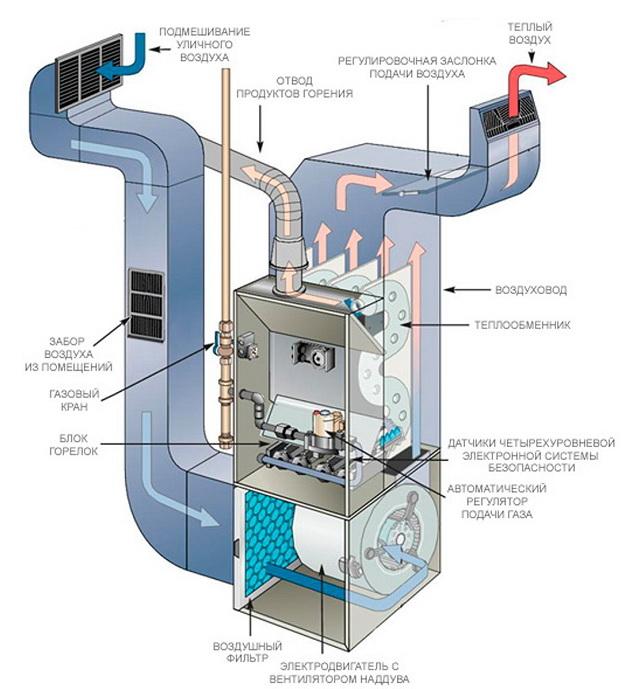

With the help of a boiler, the greenhouse heats up quickly and efficiently, but there is also a minus - drying the air in a heated room.
The air in the boiler washes the firebox and heats up, after which it spreads through the greenhouse using air ducts. Lack of moisture can be compensated for by placing buckets of water inside the greenhouse or using modern humidifiers.
The combustion products of the heating boiler have a high temperature, which can be used to heat the soil (through pipes).


Water heating
Heating greenhouses with a heating medium is the most common. The main elements of such a heating system are: a boiler, heating circuits (radiators, coils), a circulation pump, pipelines, fittings and protective elements.
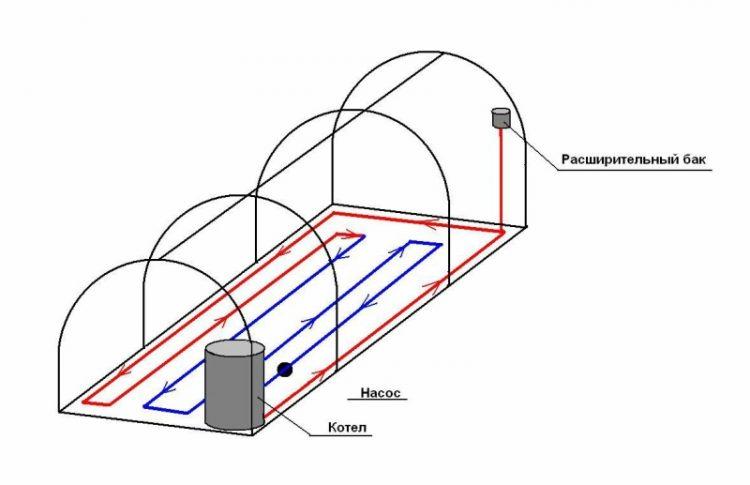

For uniform heating of the greenhouse, it is necessary to install several heating circuits at different levels in height and an underground coil of the "warm floor" type. The regulation of the air temperature in the greenhouse can be entrusted to automatic sensors-relays. The temperature will be controlled by decreasing or increasing the intensity of movement of the coolant.
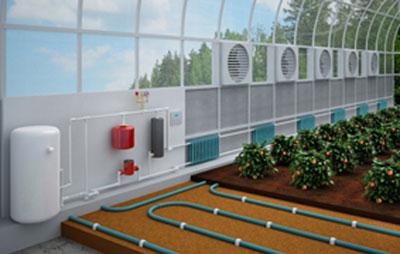

If each heating circuit has its own circulation pump and temperature relay, then an individual operating mode can be set for each circuit.
If we compare the water and air heating systems, then:
- An air heating system heats up the room faster than a water heating.
- Air heating has a simple design and does not require a lot of additional equipment, unlike water heating.
- Water heating has a laborious installation process and requires the installation of additional equipment, but it is more efficient than air heating.
Boiler selection
The choice of a boiler for heating a greenhouse directly depends on the preferred type of fuel, the size of the greenhouse and the outside air.
By the type of fuel, the units are:
- Solid fuel burns coal, peat, firewood. They are conventional, long-burning and gas-generating.
- Oil fired boilers burn diesel fuel or kerosene.
- Combined boilers can operate on various types of fuel.
- Gas boilers run on natural gas or propane-butane mixture.
- Electric boilers do not burn fuel. Heating of the coolant is carried out with the help of heating elements.
In terms of power, the unit is selected in accordance with the calculation of the heat losses of the greenhouse and its dimensions.
Wood-fired hot water boilers
Air heating units that burn wood are able to quickly heat the air in the greenhouse, while the installation of the boiler is not a laborious process.
The principle of operation of an air-heating boiler is based on the creation of natural air circulation in the greenhouse: the air heated in the boiler is sent to the greenhouse room, thereby displacing the cold air back into the boiler and this cycle is constantly repeated.
Air-heating pyrolysis (gas generating) boilers are a conventional solid fuel boiler, but with an additional firebox. It is needed to burn combustible gas that is released when burning firewood with an oxygen deficiency.
The furnaces of the pyrolysis boiler are located one above the other. Firewood is loaded into the lower one and ignition is performed. During the combustion process, pyrolysis gas is released, which accumulates in the upper furnace and ignites there, releasing heat.


Advantages of pyrolysis boilers:
- High coefficient of performance (COP).
- Relative cheapness in comparison with analogues.
- Ease of installation.
- Rapid warming up of the room.
- Long service life (from 20 years).
Disadvantages of pyrolysis boilers:
- The need for the preparation and storage of fuel.
- The need for constant ash removal and chimney cleaning.
- When the boiler is in operation, a burning smell can be emitted.
Read about household floor-standing double-circuit gas heating boilers in the article.
You can read the link about automatic boilers for long burning on wood materials -
Infrared heating
Infrared heating of the greenhouse, in addition to its direct purpose, also favorably contributes to the growth of plants, and also does not harm human health.
The air is heated using a special infrared thermal film, which is completely safe, easy to install and connect. Film heating is controlled by an automatic system and reaches 20-500C.


Principle of operation
Infrared film has instructions for its installation. This process does not require special skills, you just need to deepen it into the ground to the specified depth. Next, you need to connect to the mains. It is necessary to set the desired temperature and the heating of the greenhouse will begin in automatic mode.
When installing several temperature controls, it becomes possible to configure an individual mode for each bed.
The efficiency of infrared film is 95%. In this case, all the heat is used gradually and for its intended purpose - the soil warms up, and then the air heats up.
Electricity consumption
The average energy consumption is 60 W / h per 1 m2 of infrared film. The maximum power consumption is 240 W / h per m2. Such consumption occurs only when the film is heated from a cold state. Further operation of the heating proceeds more economically - the lower the maintained temperature, the less electricity consumption.
Greenhouse heating can be arranged in various ways, the choice of equipment is very rich, so choosing the right one is not difficult.
Types of boilers
Below is a more detailed description of the various devices.
Important! If a cyclic heating mode is used, then it is recommended to fill in antifreeze liquid, antifreeze as a liquid heat carrier.
Gas
It works with the use of liquefied or natural gas, while using water of any quality. The boiler is installed in a greenhouse in a free space. The device includes a heat exchanger, atmospheric burner, pump, expander (tank), safety valve. A working boiler heats water in a heat exchanger and, using a pump, feeds it into the system circuit. The smoke is discharged and expelled through a chimney or chimney.
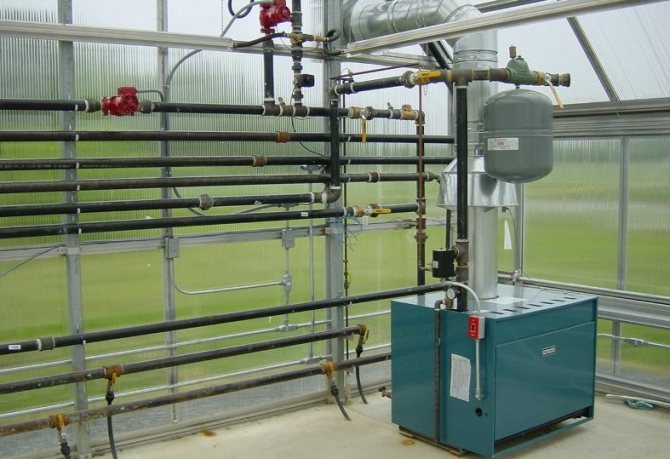

Register - heating equipment consisting of smooth-walled pipes connected by welding.Usually the tubes are located in the horizontal direction and are fixed to each other by vertical bridges, through which the coolant also moves. Often, registers are installed in heating systems intended for technical and industrial premises.
Algorithm for connecting the register to the main unit:
- Understand where the hot and cold water inlet and outlet are located in the water circuit.
- In the end parts of the register, holes are drilled for threaded couplings, which are the basis for fittings that connect the heat exchanger to the water circuit.
- With the help of a welding machine, an air vent is fixed (from the supply - on the opposite side). The optimal valve mounting location is at the top.
- Considering the large mass of the register, a reliable fastening system should be provided. When placed on the floor, these are stable legs and additional fixation to the wall.
- A distance of at least 25 cm is maintained between the register and the walls or objects surrounding it.
Did you know? The first armored car in history was designed in 1916.
—
the base of its body was a cauldron brought from the Guinness brewery.
- Advantages of heating a greenhouse using a gas boiler:
- ease of maintenance;
- very fast heating and even distribution of warm air inside the greenhouse.
- Disadvantages:
- Since the installation of the above equipment is advisable in large greenhouses, the cost of the system will be high.
- Approval is required for the connection of equipment and gas supply, which is also associated with sufficient material expenditures.
Solid fuel or pyrolysis
Pyrolysis is a chemical process that takes place at high temperatures and low oxygen content in the combustion chamber, in which excess heat energy is released. In solid fuel pyrolysis boilers, wood (or other solid fuel) is burned with the release of pyrolysis gas and the formation of coal residues. In boilers of this type, the generated gas is subsequently combusted. During combustion, carbon is oxidized not to CO², but to CO (carbon monoxide).
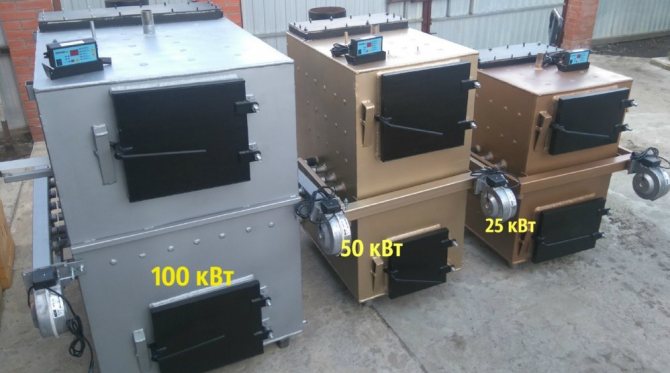

List of fuels for pyrolysis boilers:
- firewood
- briquettes;
- sawdust, shredded branches;
- pellets;
- coke;
- coal;
- peat.
Wood is the most preferable, since the process goes with the maximum release of pyrolysis gas. You can use a combination of wood with sawdust, twigs and pellets. It is not worth carrying out the heating with sawdust or finely chopped branches, since the boiler will not work or the efficiency will be extremely low.
Important! In rooms with high heat losses (solid glazing, drafts, high ceilings), it is necessary to install a boiler with increased power. If it is intended to generate hot water supply equipment, calculated
power increases by another 20
–
50%.
The sequence of operating processes for a solid fuel (wood) pyrolysis boiler:
- Firewood is loaded onto the grate.
- After igniting the fuel, close the door tightly and open the smoke exhauster.
- Air begins to flow into the upper chamber due to the pressure difference.
- The resulting pyrolysis gas is lowered into the lower furnace, in which it is burned.
- After a period of time, the air circulation stabilizes, combustion in the furnaces proceeds evenly. It is necessary to control the stability of the processes occurring in the upper and lower furnaces, remove ash from the lower chamber in a timely manner.
- During the combustion of the upper layer of fuel, the funnel-shaped distributor is lowered, thereby supplying air for permanent combustion.
- The gases generated during the combustion process are discharged through the chimney.
- Benefits:
- The efficiency reaches 90%;
- long interval between fuel loads (up to several days);
- combustion is constant, therefore, the temperature of the coolant is stable;
- comfort in equipment maintenance.
- Disadvantages:
- considerable dimensions.The height of the pyrolysis oven is higher than the usual one, on wood;
- the loaded fuel must be completely dry;
- carbon monoxide is released during combustion - you must carefully monitor the CO level sensors;
- high price.
Electrical
Electric boilers in small greenhouses are connected to a 220 V network. For large greenhouse areas - from 100 sq. m and above, the project provides for three-phase high-power units that are powered from a 380 V network. Equipment (pipes, radiators, etc.) is usually attached to the electric boiler so that there is the possibility of additional water and electric heating of the entire volume of the greenhouse.
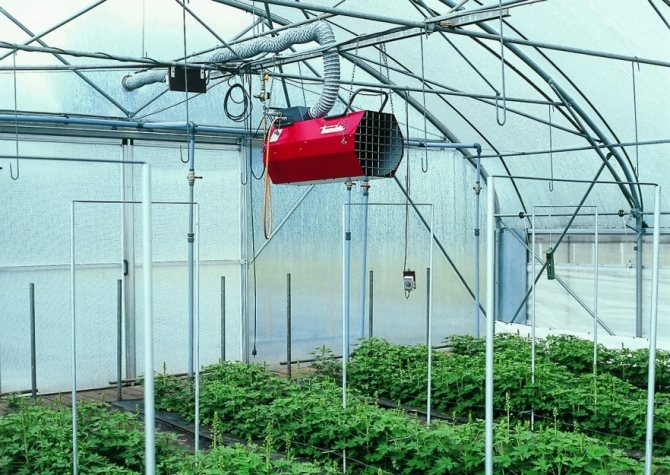

- The undoubted advantages of this type of system include the following:
- ease of installation, operation and maintenance;
- environmental friendliness (no waste of the combustion process, as well as noise during operation);
- small size;
- reliability.
- The disadvantages include the following factors:
- high cost of energy carrier;
- requires constant power grid power.
Diesel
Diesel boilers are rarely used to maintain the temperature inside the greenhouse. This is due to the fact that in addition to the large dimensions of the unit itself, it is necessary to provide for an additional location for the fuel tank. In addition, you will need additional equipment with convectors and (or) piping.
Important! If you plan to connect a gas boiler to a home-made heating system, the participation of a gas master is required. Independent work in this case is prohibited!
- The undoubted advantages are:
- high efficiency;
- automatic fuel supply;
- relatively low price of the boiler.
- Disadvantages:
- high fuel cost;
- large dimensions;
- noise during operation, the unit emits a persistent specific odor;
- the need to install a chimney;
- fire hazard.
Waste oil devices
Installing a heat generator that works with any available waste oil (engine oil, pyrolysis oil, animal and vegetable oils, crude oil, kerosene, etc.), allows you to heat the room with hot air. A furnace of this operating principle is also installed as an additional source of heat when it already exists. The specified type of device, when operated independently, requires the installation of a chimney and a fuel tank, which is not a costly measure.


- Pros:
- low cost of fuel raw materials. Devices for "working off" are especially beneficial for those who have constant access to the fuel resource (pizzerias, fast food restaurants, service stations);
- fast heating of the room due to high heat transfer;
- low cost of a repair kit.
- Minuses:
- increased oxygen consumption.
Combined
Boilers of this type allow the use of various types of fuel in any combination (depending on the model and manufacturer). Initially, it is necessary to decide which type of fuel will be priority and which will be secondary. The specified type of equipment is often formed according to the design principle.


Also, as in a single-fuel boiler, the main elements of a combined boiler are a heat exchanger, a reliably insulated casing (minimizing heat loss), and an automatic control system. For household needs, when operating in small rooms, the choice is made on a double-circuit boiler with the ability to operate on two types of fuel.
- Positive points:
- uninterrupted operation;
- selection of the preferred fuel at the time of unit operation;
- ease of use.
- Disadvantages:
- high price;
- complex commissioning;
- expensive repairs;
- the need to store several types of fuel raw materials.
We make boilers for greenhouses
In recent years, more and more people are thinking about a healthy diet without nitrates and other poisons present in purchased vegetables, fruits, greens.And many decide to grow their own food using greenhouses. For some, it becomes a lucrative business that brings pleasure and tangible income.


Greenhouse boilers
But it is not enough to install a greenhouse, you also need to heat it on cool days in order to get early vegetables. The heating issue can be solved in different ways. How to heat a greenhouse efficiently and inexpensively? What fuel should be used to heat it? Can you do it yourself? Answers to these pressing questions can be found in this article.
Features of heating greenhouse rooms
The main factor in choosing a method for heating greenhouses is the price of maintaining the temperature. After all, most greenhouses have a colossal loss of heat. Ideally, for good plant growth, the greenhouse should be built of metal profiles and plastic, with hermetically sealed glass windows.
But most vegetable growers and farmers cannot afford this method of construction, so most of the domestic greenhouses are covered with polyethylene or polycarbonate. These materials are transparent to sunlight, but they also give off a large percentage of heat to the surrounding space, so the heating of the room must be well thought out and powerful.
Greenhouse boilers
After building the greenhouse, it is necessary to start creating a heating system, the central element of which will be the boiler. The most commonly used:
- Electric - simple, easy to use and available wherever power lines are installed. But the use of such a boiler for heating the greenhouse will cost a pretty penny, besides, fan or emergency blackouts are now common, and then young plants can die from the cold.
- Gas - a stable supply of natural gas ensures good heating of the room, but the price of this energy resource is also quite high. Although many farmers use gas boilers for heating greenhouses because of the ease and speed of caring for them, it is enough to just put gas into the greenhouse and connect the boiler once - and the problems are solved. It is easy and simple to regulate and maintain the desired temperature, and the efficiency of gas heating has been proven over the years. Often, greenhouses are heated with gas by those who have this room next to a gasified house.
Gas boilers are available, and a conventional indoor floor standing version of suitable capacity will do for the greenhouse. The combustion products do not need to be removed outside the greenhouse, because all carbon dioxide is processed by plants during photosynthesis. And automation allows a person not to think about maintaining the temperature in the room.
But there are also disadvantages:
- The supply of gas to the greenhouse is rather complicated and requires the participation of special services, which will result in significant financial costs.
- During peak hours, the gas pressure may decrease, which sometimes causes the boiler to go out, and this is dangerous for the normal development of plants.
- In the winter months, gas tariffs increase with an excess of its consumption, and in order to save money, it is necessary to reduce the temperature in the greenhouse, which can negatively affect the growth of vegetables and fruits.
- Solid fuel boilers, or as they are also called, pyrolysis boilers, are used very widely, including in heating greenhouses. This is explained by their high productivity and economy, because firewood, wood scraps, waste from furniture factories, branches cut from the garden area and even dry garbage can be used for heating. These fuels are cheap and readily available, which makes these boilers attractive to greenhouse owners, since the savings in heating costs make it much cheaper to grow plants. Indeed, when heating with electric boilers, you can get golden vegetables and herbs, the costs of growing them significantly exceed the price of their sale. And solid fuel boilers are not only economical, but also easy to use.Most modern models are fully automated and require fuel loading only twice a day.


Heating greenhouses with solid fuel boilers
Heating greenhouses with solid fuel boilers makes it possible to grow plants all year round, creating your own profitable and stable business.
Solid fuel boilers are divided into:
- wood (conventional or pyrolysis);
- coal and wood;
- pellet (work on compressed pellets made of wood, seeds, straw, various waste).
Advantages of solid fuel boilers:
- environmentally friendly;
- cheap;
- aesthetic;
- available;
- safe;
- after their work, ash remains, which is an excellent fertilizer and pest control agent.
- large areas are required to store fuel;
- requires preliminary preparation of fuel;
- regular maintenance (fuel filling, ash cleaning).
Types of boilers for solid fuel greenhouses
Can be distinguished three types of the most convenient devices for use in greenhouse conditions:
- direct combustion units;
- pyrolysis boilers;
- long burning devices.
Pellet and wood burning direct combustion
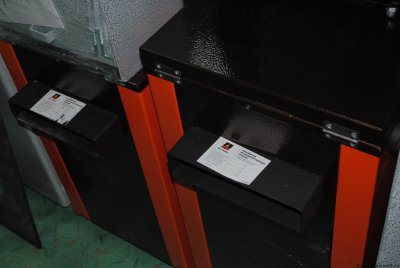

Solid fuel boilers of direct combustion are a classic example of a stove. Their device is extremely simple. - more often it is a combination of a combustion chamber, an ash storage chamber and a chimney.
Installation and operation of such a device won't cause any problems... The boiler emits heat when burning wood with high humidity, dry wood, coal, peat briquettes, pellets.
Often they are connected to such boilers Heating elements for operation from electricity either connects hot water heating system... It all depends on the specific model.
The advantages of such devices include the price... Due to the simple and straightforward design, as well as due to the lack of multiple electronics, such a boiler is not too expensive. The device will not depend on the availability of gas and electricity. So if somewhere there is an interruption in the supply of energy, the unit will not stop functioning.
The need to procure a large supply of fuel refers to the disadvantages of the design. Wood, peat and other heat sources are not the cheapest material, and you also have to pay for their periodic delivery. It will be necessary to allocate space for storing "firewood", because not all models can perceive raw materials.
Pyrolysis
Pyrolysis boilers, also known as gas generating, work on a different principle. If a standard unit burns solid fuel, releasing soot, coke and ash into the surrounding space, then the pyrolysis boiler burns not only the wood itself, but also the gas that is released from the wood under high pressure and temperature. Subsequently, the gas is driven through a special nozzle, at the exit from which the flame is close to white.
Milky fire color indicates a rather high combustion temperature, therefore, the efficiency from the same amount of wood used in a pyrolysis device and a direct combustion boiler will be completely different. Thus, the gas generator set is a cut above its predecessor.


Photo 1. Comparison of the structure of a direct combustion solid fuel boiler (left) and a pyrolysis boiler (right).
Pros: Boiler efficiency. Much more heat can be obtained from the same volume of fuel, therefore, the cost of the fuel itself will be slightly less, which will allow the device to pay for itself. The environmental friendliness of this unit will be approximately three times higherthan in a direct combustion design, since water vapor mixed with carbon dioxide escapes into the atmosphere.
The disadvantages include the price. It can scare off an inexperienced user: the simplest units cost at least 30 thousand. But the price of such devices justifies itself, and over time, the device pays off due to fuel economy.
Long burning on wood
These devices can be both pyrolysis and direct combustion... The average operating time of a long-burning pyrolysis boiler is about 8-10 hours on one tab. For full heating of the greenhouse two bookmarks per day are enough. When the boiler goes out, the generated heat circulates in the room for some time. Therefore, if the greenhouse is insulated, the temperature will drop much more slowly.
The direct combustion boiler differs from the standard unit. The main difference is in the patented combustion and air supply system, in which the top layer of the wood burns, constantly dropping down. On one wood-burning tab, such a boiler will work about 30 hours. On coal - up to 7 days.
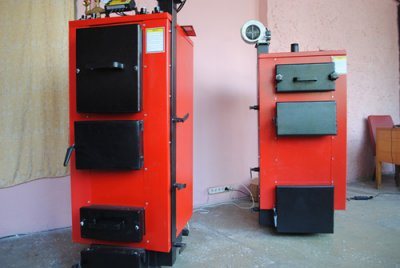

Pros: Very large fuel savings. None of the types of boilers are able to compare in terms of performance with this unit.
There is no need to constantly monitor the temperature in the greenhouse and toss firewood into the firebox.
Minuses: The price, however, any amount paid for this boiler will pay off very quickly.


